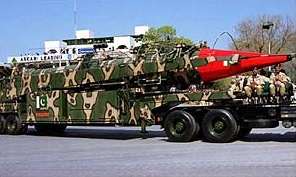|
Pakistan
on military sales offensive |
|
By Syed Saleem Shahzad |
 |
KARACHI
- The development of indigenous arms technology,
its export, joint ventures for arms production
and the exchange of defense high-tech with new
global partners is the new focus of Pakistan's
military government. Although Pakistan entered
into the field of defense production several years
ago, the present government
|
of General Pervez Musharraf wants to establish an export-oriented
defense industry that will capture a major portion of
the markets in the Middle and Far East. The Defense Exports
Promotion Organization, set up in January, has given impetus
to this program.
A successful initiative
to build Agosta 90B submarines in collaboration with
the French company DCN International has also given
Pakistan confidence to push military exports. Pakistan
signed a US$1 billion contract in 1994 with DCN International,
France's leading state-owned naval shipbuilders, under
which it acquired one fully built Agosta 90B and the
technology to construct a further two for its own use.
One Agosta has already been built at Karachi Shipyard
and Engineering Works, while the second is under construction.
When Pakistan participated
in the International Defense Exhibition and Conference
in Abu Dhabi in the United Arab Emirates in March its
Agosta 90B submarine was on display, and it has already
received offers. Negotiations are under way for Saudi
Arabia and Malaysia to buy submarines built at Pakistan's
Naval Dockyard in Karachi, at about $500 million each.
Although the overall
poor state of the economy has forced Pakistan to scale
back some of its defense projects and it will most likely
reduce its defense expenditure in the federal budget
for 2001-02 when it is delivered later this month, the
country nevertheless wants to focus on export-oriented
defense projects in collaboration with countries such
as China, Italy and France.
According to an Asian
Development Bank report, Pakistan's defense expenditure
declined from 6.3 percent of GDP in the early 1990s
to 4.8 percent in 1999-2000. Defense expenditure in
1999-2000 amounted to $2.47 billion. The report says
expenditure will further decline by 7 percent in 2000-01
when it is expected to drop to 4.6 percent of GDP.
Pakistan has lost assistance
from former partners such as the United States. Last
month, five countries in South Asia - and not Pakistan
- were designated to receive $1.85 million for military
education and training. These included Bangladesh ($525,000),
India ($650,000), Maldives ($125,000), Nepal ($225,000)
and Sri lanka ($275,000).
Pakistan has also faced
an embargo of US military aid since it detonated six
nuclear devices in May 1998. Any help and cooperation
it does receive comes with strings attached. For instance,
recently the United Statesd proposed a one-time exception
to the ban on military technology transfers to Pakistan
by offering spare parts for military helicopters, armored
vehicles and missiles on condition Islamabad sent peace-keeping
troops to Sierra Leone.
As an alternative to
the United States and some European countries including
Sweden, Britain and Germany which ban military sales
to Pakistan, Pakistani authorities are considering Italy
and France, besides China and Association of Southeast
Asian Nations (Asean) countries, for the exchange of
technology, and Middle East countries as markets.
Pakistan and China have
been collaborating on the joint production of the K-8
jet trainer aircraft for the past seven years, and they
are now said to be considering joint production of the
F-7MG and the F-8IIM high performance, multi-role, all
weather aircraft. These are top-of-the-line aircraft
in their respective categories and their induction into
the Pakistan Air Force could help to significantly redress
the present imbalance between the Indian Air Force and
the Pakistan Air Force.
Similarly, with the help
of Chinese technology, a modernized T-59 tank series
will begin production in July 2002. The Pakistan Army
has used versions of the T-59 for 30 years. The latest
upgrade will include increased firepower, mobility and
armor protection - at 10 to 15 percent of the cost of
a new battle tank.
China has also offered
to transfer technology for the manufacture of ammunition
used in the T-80 UD Ukraine tanks. This emerged following
the recent visit of Chinese Premier Zhu Rongji to Pakistan.
Musharraf recently visited
Myanmar and Vietnam, where he is also believed to have
promoted Pakistani military products. Before his arrival
in Myanmar a fleet of Pakistan naval vessels, including
a submarine, a tanker and a destroyer stopped at Yangon
Port for a three-day visit.
In the first week of
June, the secretary-general of the ministry of of defense
and chairman of the joint chiefs of staff of the Italian
government visited Pakistan to commission the Grifo
Radar manufacturing facilities in the Pakistan Aeronautical
Complex, Kamra and attended a ceremony for the formal
induction of Grifo Radar into the Pakistani fleet.
|
